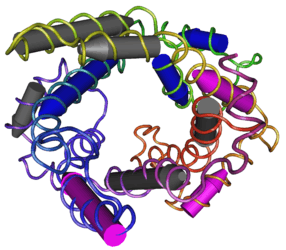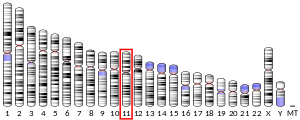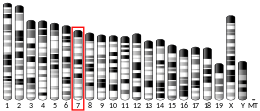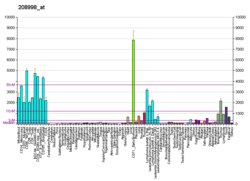UCP2
Mitochondrial uncoupling protein 2 is a protein that in humans is encoded by the UCP2 gene.[5]
Mitochondrial uncoupling proteins (UCP) are members of the larger family of mitochondrial anion carrier proteins (MACP). UCPs separate oxidative phosphorylation from ATP synthesis with energy dissipated as heat, also referred to as the mitochondrial proton leak. UCPs facilitate the transfer of anions from the inner to the outer mitochondrial membrane and the return transfer of protons from the outer to the inner mitochondrial membrane. They also reduce the mitochondrial membrane potential in mammalian cells. Tissue specificity occurs for the different UCPs and the exact methods of how UCPs transfer H+/OH- are not known. UCPs contain the three homologous protein domains of MACPs. This gene is expressed in many tissues, with the greatest expression in skeletal muscle. Although it was originally thought to play a role in nonshivering thermogenesis, obesity, diabetes and atherosclerosis, it now appears that the main function of UCP2 is the control of mitochondria-derived reactive oxygen species.[6] Chromosomal order is 5'-UCP3-UCP2-3'.[7]

See also
References
- GRCh38: Ensembl release 89: ENSG00000175567 - Ensembl, May 2017
- GRCm38: Ensembl release 89: ENSMUSG00000033685 - Ensembl, May 2017
- "Human PubMed Reference:". National Center for Biotechnology Information, U.S. National Library of Medicine.
- "Mouse PubMed Reference:". National Center for Biotechnology Information, U.S. National Library of Medicine.
- Vidal-Puig A, Solanes G, Grujic D, Flier JS, Lowell BB (Jul 1997). "UCP3: an uncoupling protein homologue expressed preferentially and abundantly in skeletal muscle and brown adipose tissue". Biochem Biophys Res Commun. 235 (1): 79–82. doi:10.1006/bbrc.1997.6740. PMID 9196039.
- Arsenijevic D, Onuma H, Pecqueur C, et al. (December 2000). "Disruption of the uncoupling protein-2 gene in mice reveals a role in immunity and reactive oxygen species production". Nat. Genet. 26 (4): 435–9. doi:10.1038/82565. PMID 11101840.
- "Entrez Gene: UCP2 uncoupling protein 2 (mitochondrial, proton carrier)".
Further reading
- Ricquier D, Bouillaud F (2000). "The uncoupling protein homologues: UCP1, UCP2, UCP3, StUCP and AtUCP". Biochem. J. 345 (2): 161–79. doi:10.1042/0264-6021:3450161. PMC 1220743. PMID 10620491.
- Saleh MC, Wheeler MB, Chan CB (2002). "Uncoupling protein-2: evidence for its function as a metabolic regulator". Diabetologia. 45 (2): 174–87. doi:10.1007/s00125-001-0737-x. PMID 11935148.
- Muzzin P (2002). "The uncoupling proteins". Ann. Endocrinol. 63 (2 Pt 1): 106–10. PMID 11994670.
- Horvath TL, Diano S, Barnstable C (2003). "Mitochondrial uncoupling protein 2 in the central nervous system: neuromodulator and neuroprotector". Biochem. Pharmacol. 65 (12): 1917–21. doi:10.1016/S0006-2952(03)00143-6. PMID 12787871.
- Paradis E, Clavel S, Bouillaud F, et al. (2004). "Uncoupling protein 2: a novel player in neuroprotection". Trends in Molecular Medicine. 9 (12): 522–5. doi:10.1016/j.molmed.2003.10.009. PMID 14659466.
- Maruyama K, Sugano S (1994). "Oligo-capping: a simple method to replace the cap structure of eukaryotic mRNAs with oligoribonucleotides". Gene. 138 (1–2): 171–4. doi:10.1016/0378-1119(94)90802-8. PMID 8125298.
- Fleury C, Neverova M, Collins S, et al. (1997). "Uncoupling protein-2: a novel gene linked to obesity and hyperinsulinemia". Nat. Genet. 15 (3): 269–72. doi:10.1038/ng0397-269. PMID 9054939.
- Gimeno RE, Dembski M, Weng X, et al. (1997). "Cloning and characterization of an uncoupling protein homolog: a potential molecular mediator of human thermogenesis". Diabetes. 46 (5): 900–6. doi:10.2337/diabetes.46.5.900. PMID 9133562.
- Boss O, Samec S, Paoloni-Giacobino A, et al. (1997). "Uncoupling protein-3: a new member of the mitochondrial carrier family with tissue-specific expression". FEBS Lett. 408 (1): 39–42. doi:10.1016/S0014-5793(97)00384-0. PMID 9180264.
- Suzuki Y, Yoshitomo-Nakagawa K, Maruyama K, et al. (1997). "Construction and characterization of a full length-enriched and a 5'-end-enriched cDNA library". Gene. 200 (1–2): 149–56. doi:10.1016/S0378-1119(97)00411-3. PMID 9373149.
- Hodný Z, Kolárová P, Rossmeisl M, et al. (1998). "High expression of uncoupling protein 2 in foetal liver". FEBS Lett. 425 (2): 185–90. doi:10.1016/S0014-5793(98)00230-0. PMID 9559644.
- Argyropoulos G, Brown AM, Peterson R, et al. (1998). "Structure and organization of the human uncoupling protein 2 gene and identification of a common biallelic variant in Caucasian and African-American subjects". Diabetes. 47 (4): 685–7. doi:10.2337/diabetes.47.4.685. PMID 9568704.
- Tu N, Chen H, Winnikes U, et al. (1999). "Structural organization and mutational analysis of the human uncoupling protein-2 (hUCP2) gene". Life Sci. 64 (3): PL41–50. doi:10.1016/S0024-3205(98)00555-4. PMID 10027754.
- Pecqueur C, Cassard-Doulcier AM, Raimbault S, et al. (1999). "Functional organization of the human uncoupling protein-2 gene, and juxtaposition to the uncoupling protein-3 gene". Biochem. Biophys. Res. Commun. 255 (1): 40–6. doi:10.1006/bbrc.1998.0146. PMID 10082652.
- Jezek P, Urbánková E (2000). "Specific sequence of motifs of mitochondrial uncoupling proteins". IUBMB Life. 49 (1): 63–70. doi:10.1080/713803586. PMID 10772343.
- Pierrat B, Ito M, Hinz W, et al. (2000). "Uncoupling proteins 2 and 3 interact with members of the 14.3.3 family". Eur. J. Biochem. 267 (9): 2680–7. doi:10.1046/j.1432-1327.2000.01285.x. PMID 10785390.
- Esterbauer H, Schneitler C, Oberkofler H, et al. (2001). "A common polymorphism in the promoter of UCP2 is associated with decreased risk of obesity in middle-aged humans". Nat. Genet. 28 (2): 178–83. doi:10.1038/88911. PMID 11381268.
- Echtay KS, Roussel D, St-Pierre J, et al. (2002). "Superoxide activates mitochondrial uncoupling proteins". Nature. 415 (6867): 96–9. doi:10.1038/415096a. PMID 11780125.
- Rupprecht A, Sittner D, Smorodchenko A, Hilse KE, Goyn J, Moldzio R, Seiler AE, Bräuer AU, Pohl EE (2014). "Uncoupling protein 2 and 4 expression pattern during stem cell differentiation provides new insight into their putative function". PLOS ONE. 9 (2): e88474. doi:10.1371/journal.pone.0088474. PMC 3921169. PMID 24523901.
- Rupprecht A, Bräuer AU, Smorodchenko A, Goyn J, Hilse KE, Shabalina IG, Infante-Duarte C, Pohl EE (2012). "Quantification of uncoupling protein 2 reveals its main expression in immune cells and selective up-regulation during T-cell proliferation". PLOS ONE. 7 (8): e41406. doi:10.1371/journal.pone.0041406. PMC 3411681. PMID 22870219.





